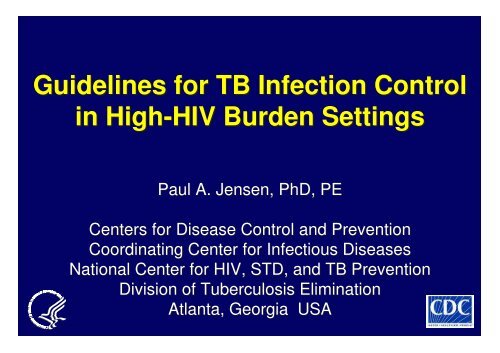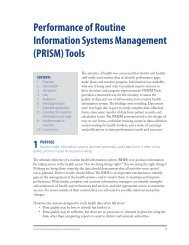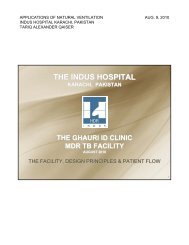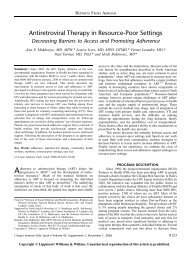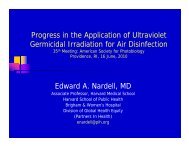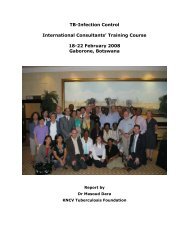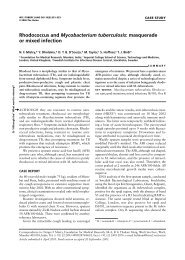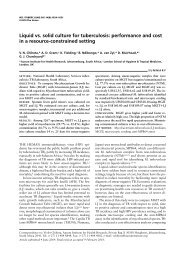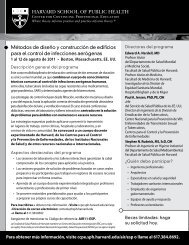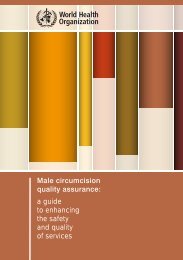Guidelines for TB Infection Control in High-HIV Burden ... - GHDonline
Guidelines for TB Infection Control in High-HIV Burden ... - GHDonline
Guidelines for TB Infection Control in High-HIV Burden ... - GHDonline
You also want an ePaper? Increase the reach of your titles
YUMPU automatically turns print PDFs into web optimized ePapers that Google loves.
<strong>Guidel<strong>in</strong>es</strong> <strong>for</strong> <strong>TB</strong> <strong>Infection</strong> <strong>Control</strong><br />
<strong>in</strong> <strong>High</strong>-<strong>HIV</strong> <strong>HIV</strong> <strong>Burden</strong> Sett<strong>in</strong>gs<br />
Paul A. Jensen, PhD, PE<br />
Centers <strong>for</strong> Disease <strong>Control</strong> and Prevention<br />
Coord<strong>in</strong>at<strong>in</strong>g Center <strong>for</strong> Infectious Diseases<br />
National Center <strong>for</strong> <strong>HIV</strong>, STD, and <strong>TB</strong> Prevention<br />
Division of Tuberculosis Elim<strong>in</strong>ation<br />
Atlanta, Georgia USA
http://www.who.<strong>in</strong>t/gtb/publications/<br />
healthcare/PDF/WHO99-269.pdf
Tuberculosis <strong>Infection</strong> <strong>Control</strong><br />
<strong>in</strong> the Era of<br />
Expand<strong>in</strong>g <strong>HIV</strong> Care and Treatment<br />
Addendum to WHO <strong>Guidel<strong>in</strong>es</strong> <strong>for</strong> the Prevention of<br />
Tuberculosis <strong>in</strong> Health Care Facilities <strong>in</strong> Resource-<br />
Limited Sett<strong>in</strong>gs, 1999<br />
CDC:<br />
WHO:<br />
IUATLD:<br />
Naomi Bock, Paul Jensen, Wanda Walton,<br />
Michael Iademarco, , Bess Miller<br />
Alasdair Reid, Pierre-Yves<br />
Norval,<br />
Paul Nunn<br />
Riitta Dlodlo
http://www.cdc.gov/mmwr/PDF/rr/rr5417.pdf<br />
http://www.cdc.gov/mmwr/PDF/rr/rr5509.pdf
Why were <strong>Guidel<strong>in</strong>es</strong> Developed?<br />
• People liv<strong>in</strong>g with <strong>HIV</strong>/AIDS receive<br />
diagnosis, care, treatment, and/or support;<br />
and<br />
• <strong>High</strong> prevalence of <strong>HIV</strong> <strong>in</strong>fection, both<br />
known and undiagnosed, <strong>in</strong> sett<strong>in</strong>gs such<br />
as prisons, jails, other detention centers,<br />
and drug rehabilitation centers.
Number and size of organisms liberated<br />
“Wells 1934, Duguid 1945, Wells/Riley 1953, et al.”<br />
Number of Organisms Liberated:<br />
Talk<strong>in</strong>g 0 – 200<br />
Cough<strong>in</strong>g 0 – 3 500<br />
Sneez<strong>in</strong>g 4500 – 1 000 000<br />
Bacteria bear<strong>in</strong>g droplets < Ø100<br />
µm<br />
Jennison [1942]<br />
Size of Droplets (Fcn(<br />
of air velocity):<br />
Sneeze<br />
~ 300 m/s<br />
Ø100µm ~ 100 m/s<br />
75 % ~ Ø10<br />
µm
Fate of Droplets<br />
• Large droplets fall to ground relatively fast.<br />
• ThefateoftheSmaller<br />
droplets will depend on<br />
the relative humidity of the air <strong>in</strong> the space.<br />
• With evaporation of droplet, “crystallisation“<br />
crystallisation” ” will<br />
occur, result<strong>in</strong>g <strong>in</strong> Droplet Nucleation, ,withthe<br />
nucleus conta<strong>in</strong><strong>in</strong>g the <strong>in</strong>fectious organism(s).<br />
• A1.0µm Droplet Nucleus will settle at a rate of<br />
0.0035 cm/s or 3 m <strong>in</strong> 24 hours!
What is <strong>Infection</strong> <strong>Control</strong>?<br />
Prevention of Transmission<br />
Patient to:<br />
Worker<br />
Patient<br />
Visitor<br />
Worker to:<br />
Worker<br />
Patient<br />
Visitor<br />
Visitor to:<br />
Worker<br />
Patient<br />
Visitor
“It may seem a strange pr<strong>in</strong>cipal to<br />
enunciate as the very first<br />
requirement of a hospital is that it<br />
should do the sick no harm.”<br />
Florence Night<strong>in</strong>gale. Notes on Hospitals, 1863
Hierarchy of <strong>Infection</strong> <strong>Control</strong>s<br />
Hierarchy of <strong>Infection</strong> <strong>Control</strong>s<br />
Worker<br />
Adm<strong>in</strong>istrative<br />
Patient<br />
Facility<br />
Environmental<br />
Respiratory<br />
protection
How can we decrease the risk?
Hierarchy of <strong>Infection</strong> <strong>Control</strong>s<br />
• Adm<strong>in</strong>istrative controls to reduce risk of<br />
exposure, <strong>in</strong>fection, and disease through policy<br />
and practice;<br />
• Environmental (eng<strong>in</strong>eer<strong>in</strong>g) controls to<br />
reduce concentration of <strong>in</strong>fectious bacilli <strong>in</strong> air <strong>in</strong><br />
areas where contam<strong>in</strong>ation of air is likely; and<br />
• Respiratory protection to protect personnel who<br />
must work <strong>in</strong> environments with contam<strong>in</strong>ated air
Adm<strong>in</strong>istrative <strong>Control</strong>s<br />
• Prevention of droplet nuclei conta<strong>in</strong><strong>in</strong>g M.<br />
tuberculosis from be<strong>in</strong>g generated;<br />
• Prevention of <strong>TB</strong> exposure to staff and patients;<br />
and<br />
• Implementation of rapid and recommended<br />
diagnostic <strong>in</strong>vestigation and appropriate<br />
treatment <strong>for</strong> patients and staff suspected or<br />
known to have <strong>TB</strong>.
Adm<strong>in</strong>istrative <strong>Control</strong> Program<br />
• <strong>Infection</strong> control plan (<strong>in</strong>clud<strong>in</strong>g <strong>TB</strong>);<br />
• Adm<strong>in</strong>istrative support <strong>for</strong> procedures <strong>in</strong> the plan,<br />
<strong>in</strong>clud<strong>in</strong>g quality assurance;<br />
• Tra<strong>in</strong><strong>in</strong>g of staff;<br />
• Education of patients and <strong>in</strong>creas<strong>in</strong>g community<br />
awareness; and<br />
• Coord<strong>in</strong>ation and communication between the<br />
<strong>TB</strong> and <strong>HIV</strong> programs.
Five Proposed Steps <strong>for</strong> Patient Management to<br />
Prevent Transmission of <strong>TB</strong> <strong>in</strong> <strong>HIV</strong> Care Sett<strong>in</strong>gs
What is Ventilation?<br />
• Movement of air<br />
• “Push<strong>in</strong>g” and/or “pull<strong>in</strong>g” of particles and<br />
vapors<br />
• Preferably <strong>in</strong> a controlled manner
Ventilation <strong>Control</strong><br />
• Types of ventilation<br />
– Natural<br />
– Local<br />
– General
Natural Ventilation
Natural Ventilation
Natural Ventilation
Natural Ventilation
Natural Ventilation
Filters Filters<br />
Filters Filters<br />
Filters Filters
Room Air Cleaners
Evaluation of Room Air Cleaners<br />
1,000<br />
Colony Form<strong>in</strong>g Units (CFUs)<br />
100<br />
10<br />
Off<br />
On<br />
Position 1<br />
Position 2<br />
Position 3<br />
Position 4<br />
Position 5<br />
Position 6<br />
Position 7<br />
Position 8<br />
Position 9<br />
L<strong>in</strong>ear<br />
1<br />
0 2 4 6 8 10<br />
Elapsed Time (hours)
Ultraviolet Germicidal Irradiation
Respiratory Protection<br />
• Respirators can protect health workers;<br />
• Frequently, they are unavailable <strong>in</strong> resource-<br />
limited sett<strong>in</strong>gs;<br />
• Respirator use should encouraged <strong>in</strong> high risk<br />
areas of hospitals and referral centers (e.g.,<br />
bronchoscopy and MDR-<strong>TB</strong>);<br />
• A CDC/NIOSH-certified<br />
N95 (orgreater)orCEN-<br />
certified FFP2 (or greater) respirator should be<br />
used; and<br />
• Use of a face mask does not protect health care<br />
workers, other staff, patients, or visitors aga<strong>in</strong>st<br />
<strong>in</strong>halation of <strong>TB</strong>.
Respirator vs. Face Mask<br />
• Respirator has only<br />
t<strong>in</strong>y pores which block<br />
droplet nuclei and<br />
relies on an air tight<br />
seal around the entire<br />
edge<br />
• Face mask has large<br />
pores and lacks air<br />
tight seal around<br />
edges
Ray’s Take-Home Message<br />
We can immediately start<br />
implement<strong>in</strong>g <strong>Infection</strong> <strong>Control</strong><br />
measures by “Th<strong>in</strong>k<strong>in</strong>g <strong>TB</strong>”


